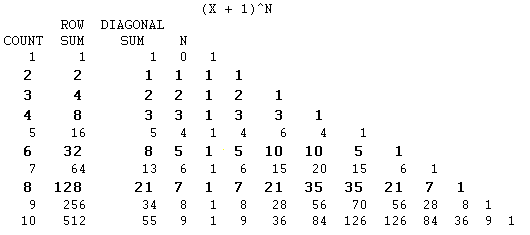
In mathematics we often times find solutions to problems by seeing patterns. In many practical branches of mathematics, such as statistics and chaos theory, patterns become critical. In the following exploration of the polynomial table, we intend to look for patterns. I report here some of the patterns I found. There are many others. After looking at the ones presented here, you are invited to see what other patterns you can find.
Computers make explorations quicker and more fun (you don't have to worry about your arithmetic). The figures presented are from the trademarked "Microsoft Excel" spreadsheet. Only the first ten rows of the table are presented. However, the table numbers are links to "Excel" files that contain more rows, along with the formulas for expanding the rows to the limits of the spreadsheet. Merely click on the link to get a copy of the file.
Polynomials are algebraic expressions. A single variable polynomial consists of a variable, say x, which is expressed as an equality as follows:

Here, the ci's are real numbers and often called coefficients, although sometimes referred to as constants. A special class of these polynomials are those that can be expressed as

For example, if n were 2, we could write the polynomial expressed by

For n = 3, we would write

In general, we can construct a table, using only a spreadsheet program, which will give us the coefficients of this polynomial for any value of n. The following is such a table

Another pattern we can see is when we add up the rows. The order of the row somes is the same as the powers of 2!

Are there other patterns? Of course. Just look at the left to right diagonals. The first one is all ones, just like the first column. The second left-right diagonal is like the second column, and so on.

How about the Fibonacci numbers; they seem to be everywhere, how about here? Well, if we add up the right to left diagonals, that's just what we get as seen in this next picture.

Notice in the previous figure I substituted the equation
 , written as (X + 1)^N, rather than Coefficient Table. This next figure inserts a column that represents the power N. I've increased the size of the appropriate rows in the next table to reflect the next pattern. Can you see what it is?
, written as (X + 1)^N, rather than Coefficient Table. This next figure inserts a column that represents the power N. I've increased the size of the appropriate rows in the next table to reflect the next pattern. Can you see what it is?

There are more patterns still to be discerned in the table presented here. I hope this presentment encourages you to seek them.